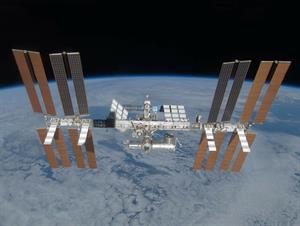
PUMPA - SMART LEARNING
எங்கள் ஆசிரியர்களுடன் 1-ஆன்-1 ஆலோசனை நேரத்தைப் பெறுங்கள். டாப்பர் ஆவதற்கு நாங்கள் பயிற்சி அளிப்போம்
Book Free DemoA space station is a huge, manned satellite in space used as a base for various space explorations.
The International Space Station (ISS) is a huge spacecraft capable of accommodating astronauts. The space station orbits the Earth at a distance of about \(400\ kilometres\). ISS also serves as a science laboratory and observatory. The main purpose of ISS is to provide an international science lab for conducting experiments in space.

International Space Station
The first section of the spacecraft was launched into orbit in \(1998\), and the construction of the main structure was finished in \(2011\).
International Space Station (ISS) is the largest man-made object in space, visible to the naked eye from Earth. In \(2000\), the first human crew was launched to the International Space Station. Since then, ISS was never unoccupied by humans. ISS will have at least six individuals on board all the time. ISS was planned to operate until \(2024\), with a possible extension until \(2028\). After \(2028\), the spacecraft might be deorbited or recycled to use in future space stations.
ISS and International Cooperation:
The International cooperation that culminated in the creation of the ISS is equally impressive as the scientific achievements of ISS. The ISS is built, maintained, and operated by an international collaboration of five distinct space organisations from \(16\) countries. The five space organisations are- NASA (USA)
- Roskosmos (Russia)
- ESA (Europe)
- JAXA (Japan)
- CSA (Canada)
The above consortium or group of space organisations includes several countries such as
- Belgium
- Brazil
- Denmark
- France
- Germany
- Italy
- Holland
- Norway
- Spain
- Sweden
- Switzerland
- United Kingdom